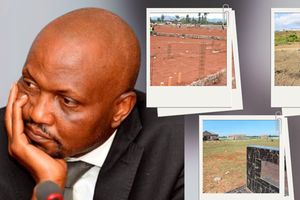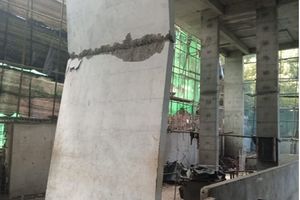Premium
The state of emergency that changed Kenya: 70 years on
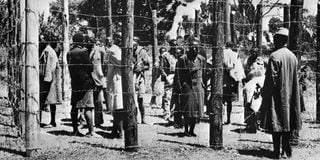
Soldiers guard Mau Mau fighters behind barbed wires, in October 1952, in the Kikuyu reserve. Mau Mau fighters fought from October 1952 to December 1959 against British colonial rule in Kenya.
What you need to know:
- Seventy years ago today, on October 20, 1952, Kenya was thrown into a dark phase after a state of emergency was declared.
- Historians agree that had the emergency period not been declared, the course of Kenya’s political history would have been different.
- The state of emergency, and the vicious violence and killings that followed, were well-plotted. The governor had discussed the emergency with London and the date agreed upon.
Seventy years ago today, on October 20, 1952, Kenya was thrown into a dark phase after a state of emergency was declared.
A battalion of Lancashire Fusiliers, flown to Nairobi ahead of the date to contain both the rising African nationalism and the political tension, had landed at Eastleigh Airport.
Historians agree that had the emergency period not been declared, the course of Kenya’s political history would have been different.
The state of emergency, and the vicious violence and killings that followed, were well-plotted. The governor had discussed the emergency with London and the date agreed upon.
The Colonial Office in London said that the declaration of a state of emergency would enable the government to detain individuals without trial.
Archival records show that on October 14, 1952, the Secretary of State for Colonies, Alan Lennox-Boyd, allowed the governor to impose a state of emergency following the rising tension in the colony after October 6, 1952, murder of Chief Waruhiu Kung’u.
Plot unearthed
Before he was killed, Waruhiu had told intelligence officers that he had unearthed a plot where all the white settlers in the colony would be killed by their servants.
It was true that the inner core of Mau Mau, previously the Forty Group, had discussed such a plot at both Kiburi House and Senior Chief Koinange’s “Kiambaa Parliament”.
Its leaders were, at first, Eliud Mutonyi, Isaac Gathanju, Bildad Kaggia and Fred Kubai.
The Special Branch had gotten wind of the plot to kill Chief Waruhiu and discussed the matter with the governor.
But the aftermath of the emergency led to the biggest shame of the British empire as it embarked on indiscriminate torture, killings and detention to sustain its hold on one of its pricey possessions in Africa.
For the last 70 years, the place of Mau Mau in Kenya’s history as a colonial disrupter has been contested by both politicians and academics.
It has been accepted, by some, as a liberation movement – as witnessed in the just-concluded campaigns where “sons of Mau Mau” invoked and embraced the movement’s fighting spirit – or as a civil war within the Mt Kenya region as advanced by some conservative scholars.
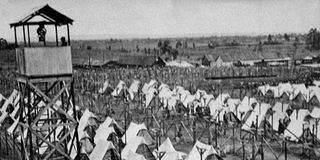
A Mau Mau detention camp in Lang’ata in April 1954.
Still, there are scholars who place Mau Mau as an anti-colonial liberation movement operating from the central Rift Valley, Nairobi and Mt Kenya region.
Moreover, Mau Mau survivors identify as freedom fighters and often dismiss notions of engaging in a civil war.
Troops' arrival
The October 20 date had been picked to coincide with the arrival of the British troops in 12 planes, which made a night landing at the Embakasi airport.
Also, the navy cruiser, HMS Kenya, carrying troops from Ceylon, was sailing to Mombasa as fear engulfed the British empire that guerilla warfare akin to what had happened in Malaya was being planned.
The naval cruiser was to be a show of force. To reinforce the troops were two thousand European volunteers.
The Mau Mau had, on the night of October 20, burnt down the exclusive Nyeri Polo Club, where the Queen had watched the Duke of Edinburg play polo, together with 300 acres of farmland.
The polo club was one of the symbols of British exclusiveness in the colony.
More so, attacks on isolated white settlers had started to take place, and there were reports of the acquisition of firearms, arson, cattle killings and other attacks whose intention was to create discomfort for the settlers.
Later, the Mau Mau would target other symbols of British luxury, including the Treetops Hotel, Limuru Golf Club and Sigona. This started to scare the white settlers on the future of what had been christened “the white man’s country”.
On October 23, the Mau Mau murdered Senior Chief Nderi, who had gone to disrupt a Mau Mau oathing ceremony while armed with a pistol, indicating that the emergency rules had not stopped Mau Mau – but had rather emboldened them.
According to police records, Nderi had “very bravely, but very foolishly” walked into the meeting yelling and screaming and had been caught by the Mau Mau and slashed to death.
A letter sent to some Europeans in Nairobi, and quoted by Reuters, summarised the nature of the rebellion: “We will kill you like you are murdering us today.
This is the voice of new Africa. This is not a threat – it is how we are feeling today. We are six million, and power is in our numbers. We shall retaliate in the method you have employed ...”
While Jomo Kenyatta’s statements on other issues were followed, it appears that he was ignored on the Mau Mau question, and thus the movement acquired its own identity minus his direct contribution and control.
Some Mau Mau survivors, however, claim that Kenyatta was still the Mau Mau figurehead.
The Kenyatta government’s failure to recognise Mau Mau as a core part of the freedom struggle only led to the seclusion of its leaders from the body politic – and created some bitterness between the fighters and the Jomo politicians over the land question.
Those who championed better treatment of Mau Mau, including Kaggia, were sidelined. As such, the land question remained unresolved and created new sites of struggle and bitterness after independence.
Kenyatta return
Everyone agrees that the return of Kenyatta from Europe in September 1946 reinvigorated the lukewarm Kenya African Union (KAU) and planted the seeds of radicalism in the body politic.
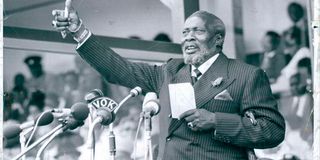
Kenya's first President Mzee Jomo Kenyatta. There is no agreement on whether Kenyatta’s alleged curse on the Mau Mau movement was genuine or tongue-in-cheek.
Kenyatta had taken over the leadership of KAU since he was better known among all the tribes and would manage to sell the party as a national movement more than its president, James Gichuru.
The number of members increased after Kenyatta took over the leadership, and it was this leadership acumen that saw him targeted for arrest during the crackdown on Mau Mau.
His arrest would turn him into a pan-African hero as Western media rebuked him and local supporters lionised him.
Before his arrest, and despite holding big rallies, there was little progress towards independence, and the militants worried that the waiting might take forever.
The Kenyatta fever was also dying. Thus, a militant wing emerged, made up of KAU members Kaggia and Kubai, among others.
Kenyatta, as they later said, was not a member of this unit, and would learn about it when he was summoned after he publicly denounced Mau Mau during the famous August 24, 1952, Kirigiti rally in Kiambu.
The rally had been organised by Waruhiu and was to bring together all Kikuyu leaders to denounce the emerging Mau Mau.
There is no agreement on whether Kenyatta’s alleged curse on the movement was genuine or tongue-in-cheek.
The interpretation of his curse would feature prominently during the Kapenguria trial, with Judge Ransley Thacker suggesting that it was coded advice to Mau Mau members to go underground.
It was after this meeting that he got to know that members of KAU were also insiders in the movement. Fifty days after the Kirigiti rally, Waruhiu was dead.
The death of Waruhiu was a turning point, and all fingers were pointed toward Muhimu, the Mau Mau central committee, which was determined to stop those opposed to its militancy. Waruhiu, to Mau Mau, was a traitor.
The crackdown on the Mau Mau movement and the villagisation policy in the Mt Kenya region altered social relations as loyalists became the targets of Mau Mau fighters.
The British reacted by seizing livestock and property belonging to perceived Mau Mau and thus created a new class of the landless – an issue that went unaddressed after independence and which still creates bitterness.
Prime Minister Winston Churchill had vowed to contain what was described as a “terrorist menace” in the Kenya colony, but he ended up with what has been described as the British gulag – a network of torture centres where men and women were forced to confess their association with Mau Mau to earn their freedom.
While the war was concentrated in the Mt Kenya region – which divides historians on whether it was a Kikuyu uprising or a nationalistic war – the end result was the end of colonialism and push the 30,000 settlers to either leave or allow the 5.5 million Kenyans to have a say in the running of the state.
The other objective was to end the white monopoly on almost all the fertile land in the country. The death of Waruhiu was the first signal that Kenya was entering a war phase between the Mau Mau freedom fighters and the colonial government.
After Waruhiu’s funeral, a 7 pm to 5.30 am curfew was imposed in Kiambu and adjacent areas, and 11 days later, a state of emergency was declared in the whole country.
The British underestimated Mau Mau, and the emergency lasted until December 12, 1960, when it was lifted.
By then, most of the radical Mau Mau fighters, including the legendary Dedan Kimathi, had been hanged. Others had been broken in detention camps.
But the political push for self-government had gained momentum, and London had admitted that Kenya colony – as a white man’s country – was no longer tenable.
Kenyatta had emerged as a moderate figure in detention and played his cards right by creating his own identity – thanks to a string of politicos who bargained for power with his image.
Mau Mau, locked out of Lancaster talks, would have no space. It is this situation that saw the rise of Kenyatta as the face of the freedom struggle rather than the Mau Mau, whose forest remnants were forced out by Kenyatta.
[email protected] @johnkamau1




